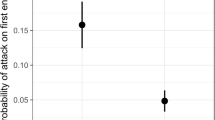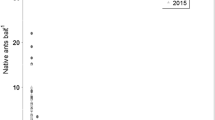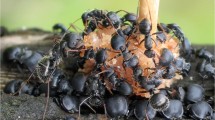Abstract
Ant communities are structured, in part, by competition between related and unrelated ant species for territories and food resources. In eastern deciduous forests of the United States, a single ant genus (Aphaenogaster) appears ecologically dominant with high abundance and opportunistic foraging. However, Aphaenogaster ants are not particularly behaviorally aggressive toward co-occurring ants, making it unclear as to how they might sustain dominance. We offered myrmecochorous seeds and termite carrion at bait stations and quantified ant aggression, food selection and recruitment. We conducted the experiments throughout the natural seed-release window to determine how the abundance of low- and high-quality food items impacted behavior. We found evidence that Aphaenogaster ants dominate the retrieval of both seeds and insect carrion (dead termites). Aphaenogaster foraging dominance did not appear driven by superior fighting or recruitment abilities but simply by having more foragers on the ground, essentially achieving control of different types of food resources through numerical dominance. Moreover, though they are the dominant effective seed dispersers in the system, A. picea exhibited a much greater affinity for termites than seeds, and the desirability of termites decreased in the presence of seeds. Overall, our results suggest that high numbers of foragers—as opposed to aggressive territoriality—can be an effective ecological strategy for sustaining ecological dominance through resource acquisition.





Similar content being viewed by others
Data accessibility
The data generated and analyzed for the current study is available in the SUNY Buffalo State Digital Commons (https://digitalcommons.buffalostate.edu/biology_data/9/).
References
Adams ES (2016) Territoriality in ants (Hymenoptera: Formicidae): a review. Myrmecol News 23:101–118
Adler FR, LeBrun EG, Feener DJ Jr (2007) Maintaining diversity in an ant community: modeling, extending, and testing the dominance-discovery trade-off. Am Nat 169:323–333
Andersen AN (2008) Not enough niches: non-equilibrial processes promoting species coexistence in diverse ant communities. Austral Ecol 33:211–220
Bates D, Maechler M, Bolker B, Walker S (2015) Fitting linear mixed-effects models using lme4. J Stat Softw 67:1–48
Bas JM, Oliveras J, Gomez C (2009) Myrmecochory and short-term seed fate in Rhamnus alaternus: Ant species and seed characteristics. Acta Oecologica 35:380–384
Beattie AJ, Hughes L (2002) Ant–plant interactions. In: Herrera CM, Pellmyr O (eds) Plant–animal interactions: an evolutionary approach. Blackwell Science, Oxford, pp 211–235
Bonabeau E, Theraulaz G, Deneubourg JL (1998) Group and mass recruitment in ant colonies: the influence of contact rates. J Theor Biol 195:157–166
Buczkowski G, Bennett G (2007) Protein marking reveals predation on termites by the woodland ant, Aphaenogaster rudis. Insectes Soc 54:219–224
Buczkowski G, Bennett G (2008) Behavioral interactions between Aphaenogaster rudis (Hymenoptera: Formicidae) and Reticulitermes flavipes (Isoptera: Rhinotermitidae): the importance of physical barriers. J Insect Behav 21:296–305
Carroll CR, Janzen DH (1973) The ecology of foraging by ants. Annu Rev Ecol Syst 4:231–258
Cerda X, Arnan X, Retana J (2013) Is competition a significant hallmark of ant (Hymenoptera: Formicidae) ecology? Myrmecol News 18:131–147
Christensen RHB (2019) Regression models for ordinal data. R package version 2019.12-10. https://CRAN.R-project.org/package=ordinal
Clark RE, King JR (2012) The ant, Aphaenogaster picea, benefits from plant elaiosomes when insect prey is scarce. Environ Entomol 41:1405–1408
Culver DC, Beattie AJ (1978) Myrmecochory in Viola: dynamics of seed-ant interactions in some West Virginia species. J Ecol 66:53–72
Fellers JH (1987) Interference and exploitations in a guild of woodland ants. Ecology 68:1466–1478
Fischer RC, Richter A, Hadacek F, Mayer V (2008) Chemical differences between seeds and elaiosomes indicate an adaptation to nutritional needs of ants. Oecologia 155:539–547
Gammans N, Bullock JJ, Schonrogge K (2005) Ant benefits in a seed dispersal mutualism. Oecologia 146:43–49
Garrido JL, Rey PJ, Cerda X, Herrera CM (2002) Geographical variation in diaspore traits of an ant-dispersed plant (Helleborus foetidus): are ant community composition and diaspore traits correlated? J Ecol 90:446–455
Gibb H, Johansson T (2011) Field tests of interspecific competition in ant assemblages: revisiting the dominant red wood ants. J Anim Ecol 80:548–557
Gorb SN, Gorb EV (1995) Removal rates of seeds of five myrmecochorous plants by the ant Formica polyctena (Hymenoptera: Formicidae). Oikos 73:367–374
Gorb EV, Gorb SN (2003) Seed dispersal by ants in a deciduous forest ecosystem. Kluwer, Dordrecht
Hölldobler B, Wilson EO (1990) The ants. Belknap, Cambridge
Hughes L, Westoby M (1992) Effect of diaspore characteristics on removal of seeds adapted for dispersal by ants. Ecology 73:1300–1312
King JR, Tschinkel WR (2016) Experimental evidence that dispersal drives ant community assembly in human-altered ecosystems. Ecology 97:236–249
King JR, Warren RJ II, Bradford MA (2013) Social insects dominate eastern US temperate hardwood forest macroinvertebrate communities in warmer regions. PLoS ONE 8:e75843
Lanza J, Schmitt MA, Awad AB (1992) Comparative chemistry of elaisomes of three species of Trillium. J Chem Ecol 18:209–221
Leal LC, Lima M, de Oliveira AF, Andersen AN, Leal IR (2014) Myrmecochores can target high-quality disperser ants: variation in elaiosomes traits and ant preferences for myrmecochorous Euphorbiaceae in Brazilian Caatinga. Oecologia 174:493–500
Lubertazzi D (2012) The biology and natural history of Aphaenogaster rudis. Psyche 2012:752815
Maynard DS, Crowther TW, King JR, Warren RJ II, Bradford MA (2015) Temperate forest termites: ecology, biogeography, and ecosystem impacts. Ecol Entomol 40:199–210
Mitchell CE, Turner MG, Pearson SM (2002) Effects of historical land use and forest patch size on myrmecochores and ant communities. Ecol Appl 12:1364–1377
Ness JH, Morin DF (2008) Forest edges and landscape history shape interactions between plants, seed-dispersing ants and seed predators. Biol Conserv 141:838–847
Ness JH, Morin DF, Giladi I (2009) Uncommon specialization in a mutualism between a temperate herbaceous plant guild and an ant: Are Aphaenogaster ants keystone mutualists? Oikos 12:1793–1804
Parr CL, Gibb H (2009) Competition and the role of dominant ants. In: Lach L, Parr CL, Abbott KL (eds) Ant ecology. Oxford University Press, Oxford, pp 77–96
Parr CL, Gibb H (2011) The discovery–dominance trade-off is the exception, rather than the rule. J Anim Ecol 81:233–241
Pinheiro J, Bates D, DebRoy S, Sarkar D, R Core Team (2019) nlme: Linear and Nonlinear Mixed Effects Models. R package version 3.1-143. https://CRAN.R-project.org/package=nlme
R Development Core Team Version 3.5.1 (2019) R: a language and environment for statistical computing, 3rd.5.0 edn. R Foundation for Statistical Computing, Vienna
Radford AE, Ahles HE, Bell CR (1968) Manual of the vascular flora of the Carolinas. The University of North Carolina Press, Chapel Hill
Rico-Gray V, Oliveira P (2007) The ecology and evolution of ant–plant Interactions. The University of Chicago Press, Chicago
Roulston TH, Buczkowski G, Silverman J (2003) Nestmate discrimination in ants: effect of bioassay on aggressive behavior. Insectes Soc 50:151–159
Stuble KL, Rodriguez-Cabal MA, McCormick MK, Juric I, Dunn RR, Sanders NJ (2012) Tradeoffs, competition, and coexistence in eastern deciduous forest ant communities. Oecologia 171:981–992
Stuble KL, Juric I, Cerda X, Sanders NJ (2017) Dominance hierarchies are a dominant paradigm in ant ecology (Hymenoptera: Formicidae), but should they be? And what is a dominance hierarchy anyways? Myrmecol News 24:71–81
Suarez AV, Tsutsui ND, Holway DA, Case TJ (1999) Behavioral and genetic differentiation between native and introduced populations of the Argentine ant. Biol Invasions 1:43–53
Warren RJ II, Giladi I (2014) Ant-mediated seed dispersal: a few ant species (Hymenoptera: Formicidae) benefit many plants. Myrmecol News 20:129–140
Warren RJ II, Giladi I, Bradford MA (2010) Ant-mediated seed dispersal does not facilitate niche expansion. J Ecol 98:1178–1185
Warren RJ II, Giladi I, Bradford MA (2012) Environmental heterogeneity and interspecific interactions influence occupancy be key seed-dispersing ants. Environ Entomol 41:463–468
Warren RJ II, Giladi I, Bradford MA (2014) Competition as a mechanism structuring mutualisms. J Ecol 102:486–495
Warren RJ II, McMillan A, King JR, Chick L, Bradford MA (2015a) Forest invader replaces predation but not dispersal services by a keystone species. Biol Invasions 23:3153–3162
Warren RJ II et al (2015b) Cryptic indirect effects of exurban edges on a woodland community. Ecosphere 6:218
Warren R II, Reed K, Mathew A, Krupp K, Goodman M, Archibald K, Spiering DJ (2018) Release from intraspecific competition promotes dominance of a non-native invader. Biol Invasions. https://doi.org/10.1007/s10530-018-1868-z
Warren RJ II, Elliott KJ, Giladi I, King JR, Bradford MA (2019) Field experiments show contradictory short- and long-term myrmecochorous plant impacts on seed-dispersing ants. Ecol Entomol. https://doi.org/10.1111/een.12666
Acknowledgements
This research was supported by the Yale School of Forestry and Environmental Studies. The authors thank Itamar Giladi for a friendly review of an early draft of the mansucript and two anonymous reviewers for helpful comments on the final manuscript.
Author information
Authors and Affiliations
Corresponding author
Rights and permissions
About this article
Cite this article
Warren, R.J., King, J.R. & Bradford, M.A. Disentangling resource acquisition from interspecific behavioral aggression to understand the ecological dominance of a common, widespread temperate forest ant. Insect. Soc. 67, 179–187 (2020). https://doi.org/10.1007/s00040-020-00750-z
Received:
Revised:
Accepted:
Published:
Issue Date:
DOI: https://doi.org/10.1007/s00040-020-00750-z




